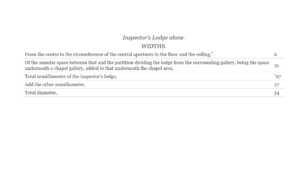In this post and accompanying video, I give a quick overview of Jeremy Bentham and the Panopticon Prison.
Table of Contents
Bentham and the Panopticon prison
Jeremy Bentham was a philosopher and reformist who lived in the eighteenth and nineteenth century in England. Bentham developed many ideas that were quite radical for that time, and one of these ideas was that of the Panopticon.

Jeremy Bentham
The idea of the Panopticon was actually first developed not by Jeremy Bentham, but by his brother, Samuel Bentham. And then Jeremy Bentham further built on that idea.

Samuel Bentham
What is the Panopticon?
The Panopticon is an institutional building where people are kept under inspection, whether it is a hospital, a school, public housing for poor people, a factory, or a mental health institution, but the most famous application is that of a prison.
The essence of the Panopticon is that of central inspection. According to Bentham, it would be ideal if the people who were kept in an institution, so the inmates in the case of a prison, were constantly being watched by the inspectors. The thing is that that would be fairly impossible, because one would need a very high number of inspectors, of course. So, according to Bentham, the next best thing would be that the inmates feel like they’re being constantly watched, even if that is not the case. And so, central in the idea of the Panopticon is that the inmates feel like they’re constantly being watched.
Bentham’s Panopticon
Seeing Without Being Seen
This feeling of being constantly being watched is achieved in the Panopticon through two inter-linked elements. The first element is that the inspector should be central; he or she should have a central position in the prison. The second element is the idea of “seeing without being seen,” meaning that the inspector should be able to watch the inmates, but not be seen by them. If the inmates would be able to see the inspector, then they would know when he or she is watching them and when he or she is not watching them. But if the inmates can’t see the inspector, then they don’t really know whether he’s not watching them or not. And, according to Bentham, that would lead the inmates to believe that the inspector might be constantly watching them.
In other words, the inspector needs to have a central position in the prison, so that he can see the inmates, but at the same time, they should not be able to see him. Now, in order to achieve that aim that inmates are under the impression that they might constantly be watched, Bentham placed a central importance on architecture.
Prison Architecture
Drawing of the circular Panopticon
More specifically, he designed the Panopticon prison to be circular. A circular building with the inspector being in the middle of it would allow the inspector to easily see all of the cells. All he would have to do is turn around occasionally to see the other half of the cells behind him. In Bentham’s design, the cells of the inmates would be along the circular walls, and all of the cells would have windows in the outer wall. In the middle of the circle is what Bentham calls the “inspector’s lodge”. From that lodge, the inspector can see into each cell, because the cells have an iron grating that the inspector can look through. At the same time, the inmates can’t see the inspector, because the inspector’s lodge has blinds. In other words, the inspector is central and can see without being seen. In that position, the inspector would be able to observe everything that goes on in the prison. In Bentham’s words: “Not a drop of forbidden liquor can be either drunk in the house, or so much as introduced into it, without being seen…” Also, the idea was that inmates couldn’t communicate with each other, and to enable that, there were barriers between the cells that extended a few feet beyond the iron grating.
According to Bentham, one of the advantages of the Panopticon over other prisons was that it was relatively cheap. Only a small number of inspectors would be needed to watch all of the inmates. Plus, the inmates would work while being incarcerated which would bring in money. Other advantages of the Panopticon prison were, for example, that it would be relatively safe for the correctional officers, and that infections would not be able to spread easily, because people wouldn’t have a lot of contact with each other.
![]()
![]()
Prison Management
In terms of management, Bentham said that he would do it by contract, offering the management of the prison to the person who offered the best deal. The manager would then be required to disclose and print all of the details about the management of the prison.
Bentham’s ideas about the Panopticon were quite detailed, covering the central concept all the way through to details such as the size of the cells, where exactly the staircase should be located, how meals will be distributed. For example, he added exact measures for the cells in the prison and for the inspector’s lodge.

Fragment of Bentham’s writings with detailed measures of the Inspector’s Lodge
Panopticon Prison Examples
But, despite Bentham’s lobbying for the prison, the Panopticon in the end was never built. It was not easy to put the idea of a central inspector who could watch the inmates without being seen by them into practice. There are several correctional facilities that come closest to the original Panopticon design by having the circular shape and a central inspection tower. Those include, for example, the circular prison of Haarlem in The Netherlands, and the prison of Breda, also in The Netherlands. Both of them are now closed. Another example is the Presidio Modelo prison in Cuba which had five circular blocks. Fidel and Raul Castro were once held here. That prison is now also closed.

The circular “Koepelgevangenis” in Arnhem, The Netherlands

Presidio Modelo prison, Cuba
Some of the criticisms on the Panopticon are among others that, like other works by Bentham, it does not seem to be very humane. Bentham’s approach is quite rational and mechanistic and does usually not view individuals as human beings.
Interestingly though, some people have argued that the way in which modern technology operates is similar to Bentham’s Panopticon. Public places are watched by CCTV, and so people who are in those places are seen without seeing. Similarly, people’s internet and computer usage may be watched without them being able to see whether or not they’re being watched. So in a sense, Bentham’s Panopticon may have become a reality even when the prison that he designed was never built.
If you’re interested in reading more about Bentham’s ideas, check out a quick overview of his ideas about utilitarianism here.
Bentham’s original writings on the Panopticon can be found here.
![]()
